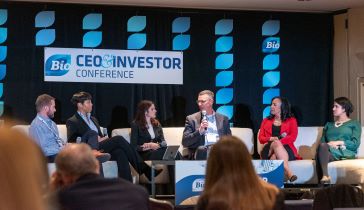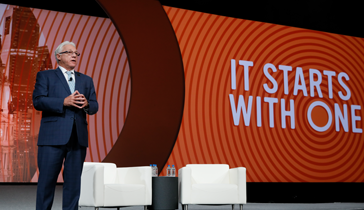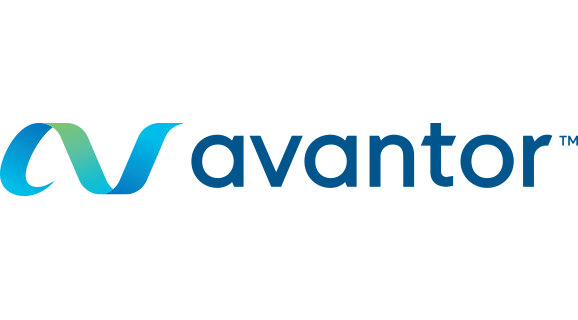GoodDay BIO: How can we incentivize innovation? Wall Street, Washington insiders, and biotechs discuss.
We’re seeing an “extraordinary level” of biotech innovation, said BIO Chair Jeremy Levin, CEO of Ovid Therapeutics Inc., while kicking off the 22nd BIO CEO & Investor Conference on February 10th in New York.
Day #1 of the conference featured discussions about the breakthrough therapies of the future—and what we need to happen in terms of investment and policy to get there.
But alongside this exciting science are very real challenges. Public perception of the industry is low. The NASDAQ Biotechnology Index (NBI) rises and falls based on what’s happening in Washington—and there, we’re seeing harmful policy proposals and political chaos, while across the country, industry consolidation is “the unseen shark…that has the potential to completely undermine our industry,” as Levin said.
How do we incentivize funding for these new cures and ensure policy supports bringing them to market?
Wall Street investors, Washington experts, and innovative CEOs and scientists from around the world provided some ideas, but one thing’s clear: both the scientists and the policymakers must put patients first.
Here’s a look at the opportunities and challenges ahead, in this special edition of Good Day BIO on the Road.
The Wall Street Outlook
As BIO CEO Jim Greenwood says, “the science is galloping forward”—and science was on full display at the conference, as companies researching everything from precision oncology to treatments for cardiovascular and regenerative diseases and breakthrough gene therapies pitched to investors.
What’s driving investment?
Last year, the core drivers of industry mergers, deals, and investment were things like cost and patent cliffs, said E. Eric Tokat, Partner at Centerview Partners LLC, speaking at the end of the day. But this year, it’s science.
Speaking on an all-women panel about commercialization strategies specifically for small and mid-sized biotechs, Shawn Tomasello, Board Member of Urogen Pharma Inc., said companies need to think about how they communicate about their science and their drug. It’s important to have passion, but you need to ask, “What does that really mean to the patient?”
Selling gene therapy is the next wave, said Geoff Meyerson, CEO and Co-Founder of Locust Walk. But if you actually look at deals, he said, there’s still an awful lot of small molecule deals getting done and an awful lot of small molecule therapies getting approved by the FDA.
“There’s still a lot of value in the traditional types of assets.”
But there are challenges ahead.
“We’re on the first or second inning of scientific revolution. We will continue to see dealmaking,” said Tokat—but the uncertainty, specifically with the election and drug pricing, could derail it.
Some challenges relate to the science. In addition to finding a standardized, efficient way of producing clinical and commercial scale of new gene and cell therapy treatments, safety is another concern.
“Can the system handle one really bad gene therapy safety event?” asked Philip Ross, Vice Chairman of JP Morgan. Will the event take down just one company, or make people lose their appetite for investing in this kind of therapy generally?
Data is another. “The biggest trend isn’t therapeutic—it’s data,” said Andrew Gitkin, Managing Director and Co-Head of Healthcare Investment Banking at Raymond James. There’s never been more data being generated pre-clinically or clinically, and “the recurring theme is how do we make heads or tails of this data.”
This includes clinical and economic data, said Dr. Jing L. Marantz, Head of Medical Affairs for Alnylam Pharmaceuticals. “But it’s more than that,” she said. You must include patient voices and let payors know the drug works.
How can companies secure investment in this environment?
Pay attention to the science, investors agreed. “If you help patients, it will all fall into place,” said Tokat.
Similarly, focus is important when you’re trying to launch a product to help people in an environment with so many challenges stacked against you. “You can’t build a company to be sold. You have to build a company to impact human health,” said Ross.
Focus and invest in a program in an optimal way, versus multiple programs sub-optimally, added Gitkin.
The bottom line:
“We will look back on this year and say it was a great year for biotechs,” concluded Tokat. But this could be derailed by reimbursement or drug pricing, an Elizabeth Warren or Bernie Sanders nomination, “which would create a very different biotech valuation environment.”
The Washington Outlook
“Is an election-year compromise on anything possible?” asked BIO Chair Jeremy Levin in the opening session. Throughout the day, this question was top of mind for many speakers.
The state of play:
During a session focused on the election and policy , BIO CEO Jim Greenwood explained the House-passed H.R. 3 centered on an international price index, or IPI, is “DOA” in the Senate and the bipartisan Grassley-Wyden bill in the Senate is “an opportunity to get a deal,” any deal is “a long shot.”
The date to watch:
May 22, 2020, the deadline to renew funding for health care extenders, which could be a vehicle for policymakers to address drug pricing or out-of-pocket costs.
If nothing happens by the spring, it’s unlikely to happen this year.
Will Trump move forward with his IPI?
It’s still a possibility, though Sarah Butler Donovan, Head of Client Solutions, Marketing & Ops for Avalere Health, said it’s “probably a positive sign for the industry” it wasn’t specifically mentioned in the State of the Union, though there’s concern the administration and Speaker Nancy Pelosi, who led H.R. 3, may try to make a deal to get an index through.
Can this happen in an election year?
Most likely not, because Pelosi doesn’t want to give Trump the win, and Trump wants to accomplish too much—but we have to remain vigilant about the possibility of an international price index while also continuing to push for policy that will address out-of-pocket costs in a meaningful way.
Who’s going to win in November, anyway?
Views are mixed; Jim thinks Democrats can sweep the whole thing, while Wall Street investors speaking later in the afternoon think Trump could get reelected and a left-wing Democratic nominee will bring more volatility to the investment climate.
What’s the industry thinking about the FDA?
Under the leadership of the new FDA Commissioner Stephen Hahn, expect the agency to be “largely the same,” said investors, noting there hasn’t been any significant change or even hints of significant change to the status quo.
Jim’s Judgment:
“What people are angry about is not the price of drugs, but what they pay,” said Jim. “The primary fact on the ground that needs to be changed is patient out-of-pocket cost—and let’s start with Part D.”
Click here to read more about whether this can happen and what that might look like.
The China Outlook
Between the trade war, the Committee on Foreign Investment in the United States (CFIUS) regulations, and coronavirus, China M&A has been a bit rocky. Here's what to expect.
The outlook for trade and investment:
Kimberly Nearing, Venture Partner of BVCF Management Ltd and a member of the Board of BayHelix, said cross-border M&As are “flat but active” and partnering is up 30% despite the uncertainty, showing there’s interest on both sides in maintaining investment and business flowing between the two countries.
The impact of the trade war:
The trade war “is a self-inflicted wound we imposed on ourselves,” she said. “Our biotech companies were benefitting greatly from the influx of capital from China for a number of years,” but this has gone down dramatically.
While capital has decreased, however, Geoff Meyerson, CEO and Co-Founder of Locust Walk, said we’re nonetheless still seeing deals.
“China is still a wild card,” said Carol Lynch, President of Sandoz US and Head of North America, Sandoz, speaking during a fireside chat. China is looking at regulations across the board, as well as opportunities to harmonize regulations and get closer to US/EU regulations, “but how that lands will be interesting to watch,” she said.
Nearing added that we’re seeing licensing deal terms “become more western,” with things like up-front equity and strong royalty packages, which is good news.
And the coronavirus?
Several investors said they were worried about the virus, with Tokat stating he worries we might be underestimating the severity. And that many people on lockdown is not something to brush off, he said.
Nearing was more optimistic: “This too will pass,” she said
Don’t give away your China rights, said Nearing. And have good partners in the country.
The Bottom Line: Incentivize New Cures, Put Patients First
Across the board, speakers agreed: everyone, from biotech companies to policymakers, must put patients first. And a meaningful out-of-pocket fix can achieve that.
“I believe in the social contract,” said Jeremy Levin in the opening session.
“Be part of the solution,” he implored companies. “It’s great to have a medicine, but you’ve got to get it to them, and it’s got to be safe, effective, and affordable.”
It’s important for policymakers to have the same goal.
“I would like Congress to focus on patients,” said BIO Vice Chair Paul Hastings, CEO of Nkarta Therapeutics.
When it comes to prescription drug policy, there are two “moral principles” to keep in mind, said Greenwood. First, no one should ever do without the medicine they need because they cannot afford the out-of-pocket cost. Second, no policy should ever be acceptable to an elected official if it drives money away from innovation in biotech.
“If you follow those two principles—and you can—we can take care of patients, we can take care of payors, we can take care of costs, and we can have innovation.”
Let’s hope someone’s listening.


















.png)


